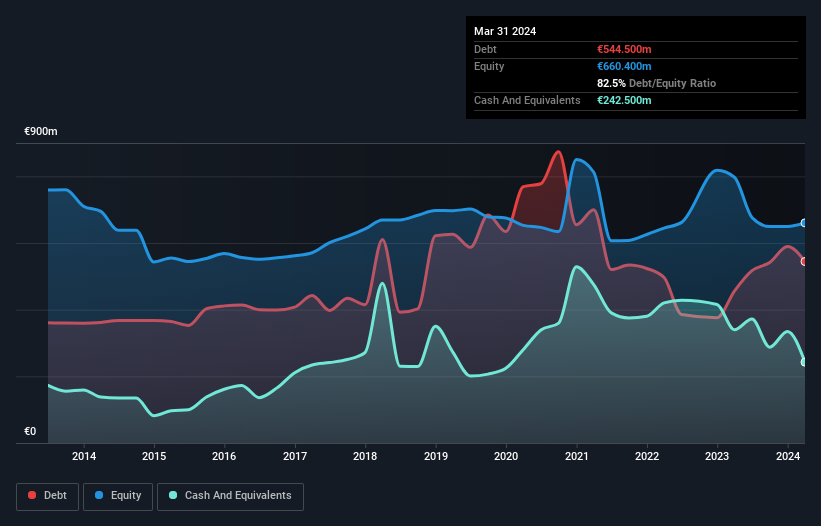
Howard Marks put it nicely when he said that, rather than worrying about share price volatility, 'The possibility of permanent loss is the risk I worry about... and every practical investor I know worries about.' It's only natural to consider a company's balance sheet when you examine how risky it is, since debt is often involved when a business collapses. Importantly, ENCE Energía y Celulosa, S.A. (BME:ENC) does carry debt. But is this debt a concern to shareholders?
When Is Debt Dangerous?
Debt is a tool to help businesses grow, but if a business is incapable of paying off its lenders, then it exists at their mercy. Ultimately, if the company can't fulfill its legal obligations to repay debt, shareholders could walk away with nothing. However, a more common (but still painful) scenario is that it has to raise new equity capital at a low price, thus permanently diluting shareholders. Of course, the upside of debt is that it often represents cheap capital, especially when it replaces dilution in a company with the ability to reinvest at high rates of return. The first thing to do when considering how much debt a business uses is to look at its cash and debt together.
View our latest analysis for ENCE Energía y Celulosa
What Is ENCE Energía y Celulosa's Net Debt?
The image below, which you can click on for greater detail, shows that at March 2024 ENCE Energía y Celulosa had debt of €544.5m, up from €455.8m in one year. However, because it has a cash reserve of €242.5m, its net debt is less, at about €302.0m.

How Strong Is ENCE Energía y Celulosa's Balance Sheet?
The latest balance sheet data shows that ENCE Energía y Celulosa had liabilities of €416.7m due within a year, and liabilities of €576.7m falling due after that. Offsetting these obligations, it had cash of €242.5m as well as receivables valued at €78.6m due within 12 months. So its liabilities total €672.3m more than the combination of its cash and short-term receivables.
This deficit is considerable relative to its market capitalization of €877.0m, so it does suggest shareholders should keep an eye on ENCE Energía y Celulosa's use of debt. Should its lenders demand that it shore up the balance sheet, shareholders would likely face severe dilution. When analysing debt levels, the balance sheet is the obvious place to start. But ultimately the future profitability of the business will decide if ENCE Energía y Celulosa can strengthen its balance sheet over time. So if you want to see what the professionals think, you might find this free report on analyst profit forecasts to be interesting.
In the last year ENCE Energía y Celulosa had a loss before interest and tax, and actually shrunk its revenue by 26%, to €795m. That makes us nervous, to say the least.
Caveat Emptor
While ENCE Energía y Celulosa's falling revenue is about as heartwarming as a wet blanket, arguably its earnings before interest and tax (EBIT) loss is even less appealing. Indeed, it lost €28m at the EBIT level. Considering that alongside the liabilities mentioned above does not give us much confidence that company should be using so much debt. So we think its balance sheet is a little strained, though not beyond repair. However, it doesn't help that it burned through €94m of cash over the last year. So in short it's a really risky stock. The balance sheet is clearly the area to focus on when you are analysing debt. But ultimately, every company can contain risks that exist outside of the balance sheet. We've identified 1 warning sign with ENCE Energía y Celulosa , and understanding them should be part of your investment process.
At the end of the day, it's often better to focus on companies that are free from net debt. You can access our special list of such companies (all with a track record of profit growth). It's free.
Valuation is complex, but we're here to simplify it.
Discover if ENCE Energía y Celulosa might be undervalued or overvalued with our detailed analysis, featuring fair value estimates, potential risks, dividends, insider trades, and its financial condition.
Access Free AnalysisHave feedback on this article? Concerned about the content? Get in touch with us directly. Alternatively, email editorial-team (at) simplywallst.com.
This article by Simply Wall St is general in nature. We provide commentary based on historical data and analyst forecasts only using an unbiased methodology and our articles are not intended to be financial advice. It does not constitute a recommendation to buy or sell any stock, and does not take account of your objectives, or your financial situation. We aim to bring you long-term focused analysis driven by fundamental data. Note that our analysis may not factor in the latest price-sensitive company announcements or qualitative material. Simply Wall St has no position in any stocks mentioned.
Have feedback on this article? Concerned about the content? Get in touch with us directly. Alternatively, email editorial-team@simplywallst.com
About BME:ENC
ENCE Energía y Celulosa
Produces and sells eucalyptus hardwood pulp and renewable energy in Spain, Germany, Poland, Italy, the Netherlands, the United Kingdom, Greece, Turkey, and internationally.
Fair value with moderate growth potential.
Similar Companies
Market Insights
Community Narratives



